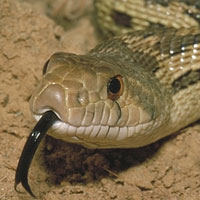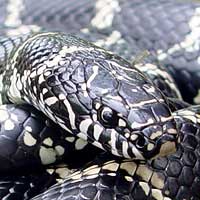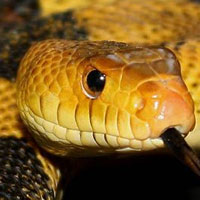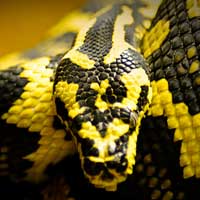Everything You Need to Know About the Nose-horned Viper
The Nose-horned Viper (Vipera ammodytes) belongs to the Viperidae snake family, known for its venomous species equipped with long, hinged fangs and heat-sensing pits, making it an efficient predator. This snake is native to Southern Europe and parts of the Middle East, thriving in rocky terrains, dry meadows, and woodland edges, and is easily identified by the unique horn-like scale on its snout.
Scientific Name: Vipera ammodytes
Snake Family: Viperidae
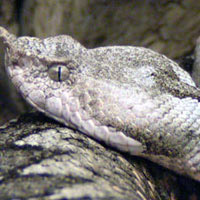
An Overview of the Nose-horned Viper
The Nose-horned Viper (Vipera ammodytes) is a venomous snake native to Southern Europe and parts of the Middle East. It is easily recognized by the distinctive horn-like scale on its snout, which gives the species its name. Known for its potent venom and remarkable camouflage, the Nose-horned Viper is a highly adaptable predator that thrives in rocky terrains and wooded areas. Despite its venomous bite, this snake is shy and will only strike when provoked, making it a vital component of its ecosystem for controlling rodent populations.
Where Does the Nose-horned Viper Live?
The Nose-horned Viper occupies a wide range of habitats across its geographic range. Key habitat characteristics include:
- Geographic Range: Found in Southern Europe, the Balkans, and parts of the Middle East, including Greece, Turkey, and Iran.
- Preferred Environments: Rocky terrains, dry meadows, woodland edges, and scrublands.
- Climate: Prefers temperate to Mediterranean climates with mild winters and hot summers.
This viper is highly adaptable and often shelters under rocks, in crevices, or beneath vegetation to escape predators and extreme weather conditions. Its ability to thrive in various terrains, including human-altered landscapes, has contributed to its resilience. Below is a table summarizing its habitat preferences:
| Habitat Feature | Description |
|---|---|
| Geographic Range | Southern Europe, Balkans, Middle East |
| Preferred Terrain | Rocky areas, woodlands, scrublands |
| Climate | Temperate to Mediterranean |
What Does the Nose-horned Viper Eat?
The Nose-horned Viper is a carnivorous predator that plays an essential role in controlling local pest populations. Key dietary details include:
- Primary Prey: Small mammals such as rodents, which make up the majority of its diet.
- Occasional Prey: Birds, lizards, and amphibians.
- Hunting Strategy: Ambush predator that relies on its camouflage to remain hidden before delivering a venomous bite to subdue prey.
The snake’s venom quickly immobilizes its prey, allowing it to consume the meal without resistance. By preying on rodents and other small animals, the Nose-horned Viper contributes significantly to maintaining ecological balance, particularly in agricultural areas prone to pest infestations.
Understanding the Behavior of the Nose-horned Viper
The Nose-horned Viper is known for its reserved and defensive behavior. Key behavioral traits include:
- Activity Patterns: Primarily diurnal during cooler months and crepuscular or nocturnal in hotter climates.
- Defensive Behavior: Relies on camouflage to avoid detection but will hiss and strike if threatened or cornered.
- Social Behavior: Solitary, except during the mating season or when hibernating in shared dens.
Despite its venomous capabilities, the Nose-horned Viper is not aggressive and avoids confrontation whenever possible. Recognizing its behavior is essential for safely coexisting with this species.
Health and Lifespan of the Nose-horned Viper
The Nose-horned Viper is a resilient species with a relatively long lifespan. Important health considerations include:
- Lifespan: 10-15 years in the wild, with individuals in captivity often living longer under optimal care.
- Health Threats: Habitat destruction, human persecution, and road mortality are significant risks to its populations.
- Predators: Birds of prey, foxes, and other larger reptiles pose threats, particularly to juveniles.
Efforts to preserve its natural habitats and educate the public about its ecological importance are vital for ensuring the long-term survival of this species.
How Does the Nose-horned Viper Reproduce?
The Nose-horned Viper has a unique reproductive cycle that ensures its survival in diverse environments. Key details include:
- Mating Season: Typically occurs in spring, with males engaging in combat for access to females.
- Reproductive Method: Ovoviviparous, meaning females give birth to live young rather than laying eggs.
- Litter Size: Produces 5-15 offspring per litter, depending on the female’s size and health.
- Hatchling Behavior: Newborns are fully venomous and independent, capable of hunting small prey immediately after birth.
The timing of reproduction and the protective behavior of females ensure higher survival rates for juveniles in their natural habitats.
Safety Guidelines for Handling the Nose-horned Viper
Handling the Nose-horned Viper requires expertise and strict safety protocols. Essential safety measures include:
- Always use professional tools such as snake hooks and secure transport containers.
- Wear protective gloves and boots to minimize the risk of envenomation.
- Ensure enclosures are escape-proof and replicate the snake’s natural habitat.
- Keep antivenom readily available and have an emergency protocol in place.
Only trained professionals should handle this species. Public education about its behavior and ecological role can help reduce fear and unnecessary harm to the snake and its handlers.
Disclaimer
The information provided in this article is for educational purposes only. SnakeEstate strongly advises against handling or interacting with venomous snakes, such as the Nose-horned Viper, unless you are a trained and licensed professional. These snakes pose significant risks, and improper handling can result in serious injury or death. Always adhere to local regulations and prioritize safety when dealing with wildlife.
Other Snakes In This Species
 Asp Viper
Asp Viper Black Mamba
Black Mamba Boomslang
Boomslang Brazilian Coral Snake
Brazilian Coral Snake Bushmaster
Bushmaster Coastal Taipan
Coastal Taipan Common Death Adder
Common Death Adder Common European Adder
Common European Adder Copperhead
Copperhead Coral Snake
Coral Snake Cottonmouth
Cottonmouth Eastern Brown Snake
Eastern Brown Snake Eastern Diamondback Rattlesnake
Eastern Diamondback Rattlesnake Egyptian Cobra
Egyptian Cobra Fer-de-lance
Fer-de-lance Forest Cobra
Forest Cobra Indian Cobra
Indian Cobra Inland Taipan
Inland Taipan Jameson’s Mamba
Jameson’s Mamba King Cobra
King Cobra Lancehead
Lancehead Lataste’s Viper
Lataste’s Viper Malayan Krait
Malayan Krait Mojave Rattlesnake
Mojave Rattlesnake New Guinea Small-eyed Snake
New Guinea Small-eyed Snake Nose-horned Viper
Nose-horned Viper Puff Adder
Puff Adder Russell’s Viper
Russell’s Viper Saw-scaled Viper
Saw-scaled Viper Solomon Island Coral Snake
Solomon Island Coral Snake South American Rattlesnake
South American Rattlesnake Tiger Snake
Tiger Snake Western Diamondback Rattlesnake
Western Diamondback Rattlesnake



